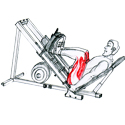-

|
-

|
| Step 1 |
Step 2 |
- Targeted Muscles:
- Additional Muscles:
- Hip Flexors
- Buttocks (gluteus maximus)
- Inner Thighs (adductors)
- To work one leg at a time, place your right leg on the floor as you perform the exercise with your left leg. After completing a full set with your left leg, repeat the exercise with your right leg. You will need to reduce the amount of weight used when working one leg. Working one leg at a time is useful if one of your legs is stronger than the other and you do not want the stronger leg compensating for the weaker leg.
- You can adjust the position of your feet on the foot plate to change the muscles targeted. To work your inner thighs and buttocks more, position your feet about 3 to 5 inches wider than shoulder width apart. To emphasize your hamstrings and buttocks more, place your feet about 2 to 3 inches higher than normal on the foot plate. You should be careful when performing these modifications if you have knee problems.
- The leg press helps build strength and endurance in your legs. The exercise focuses on your quadriceps and hamstrings, but also gives your hip flexors, buttocks and inner thighs a great workout.
- If you have trouble performing squats or lunges because of lower back problems, the leg press is a good alternative. However, you may want to avoid the leg press if you have an existing knee problem or if your knees begin to hurt during the exercise.
- There are different types of leg press machines available. Some machine require you to add weight plates to a bar while others allow you to insert a pin into a stack of weights to select the amount of weight you want to lift. Depending on the machine, either the foot plate or the body pad will move as you perform the exercise. Your position on the machine and the angle at which you press your legs to raise the weight may also be different. However, the concept of the exercise is the same for each leg press machine.
- Do not lock your knees when you straighten your legs.
- Do not raise your head off the head rest. Keep your head and neck in a line with your back.
- Do not arch your back to help you push the weight. Make sure your back remains flat against the back pad.
|











